Welsh Onion Root (Allium fistulosum) Restores Ovarian Functions from Letrozole Induced-Polycystic Ovary Syndrome
Abstract
1. Introduction
2. Materials and Methods
2.1. Preparation of A. fistulosum (Welsh Onion) Root Extract
2.2. Quantitative Analysis of Marker Compounds in A. fistulosum Root Extract
2.3. Animals and Treatments
2.4. Serum Hormone Analysis
2.5. Reverse Transcription and Real-Time PCR
2.6. Histological Analysis and Immunohistochemistry
2.7. Statistical Analysis
3. Results
3.1. Quantitative Analysis of Marker Compounds in A. fistulosum Root Extract
3.2. Animal Condition and Treatments
3.3. Effect of A. fistulosum Extract on Plasma Hormonal Level
3.4. Effects of A. fistulosum Extract on mRNA Expression and Histological Changes during Folliculogenesis
3.5. Effects of A. fistulosum Extract on Hormone Receptor-Related Genes
3.6. Effect of A. fistulosum Extract on Steroid Synthesis-Related Genes
3.7. Induction of Aromatase Following Treatment with A. fistulosum Extract Is Linked to Plasma Estradiol Level
4. Discussion
5. Conclusions
Author Contributions
Acknowledgments
Conflicts of Interest
References
- Trivax, B.; Azziz, R. Diagnosis of polycystic ovary syndrome. Clin. Obstet. Gynecol. 2007, 50, 168–177. [Google Scholar] [CrossRef] [PubMed]
- Bremer, A.A. Polycystic ovary syndrome in the pediatric population. Metab. Syndr. Relat. Disord. 2010, 8, 375–394. [Google Scholar] [CrossRef] [PubMed]
- Freeman, E.W.; Sammel, M.D.; Lin, H.; Nelson, D.B. Associations of hormones and menopausal status with depressed mood in women with no history of depression. Arch. Gen. Psychiatry 2006, 63, 375–382. [Google Scholar] [CrossRef] [PubMed]
- Silva, C.A.; Yamakami, L.Y.; Aikawa, N.E.; Araujo, D.B.; Carvalho, J.F.; Bonfa, E. Autoimmune primary ovarian insufficiency. Autoimmun. Rev. 2014, 13, 427–430. [Google Scholar] [CrossRef] [PubMed]
- Falorni, A.; Minarelli, V.; Eads, C.M.; Joachim, C.M.; Persani, L.; Rossetti, R.; Yurttas Beim, P.; Pellegrini, V.A.; Schnatz, P.F.; Rafique, S.; et al. A clinical research integration special program (CRISP) for young women with primary ovarian insufficiency. Panminerva. Med. 2014, 56, 245–261. [Google Scholar] [PubMed]
- Sahmay, S.; Usta, T.A.; Erel, T.; Atakul, N.; Aydogan, B. Elevated LH levels draw a stronger distinction than AMH in premature ovarian insufficiency. Climacteric 2014, 17, 197–203. [Google Scholar] [CrossRef] [PubMed]
- Abbott, D.H.; Barnett, D.K.; Bruns, C.M.; Dumesic, D.A. Androgen excess fetal programming of female reproduction: A developmental aetiology for polycystic ovary syndrome? Hum. Reprod. Update 2005, 11, 357–374. [Google Scholar] [CrossRef] [PubMed]
- Daneasa, A.; Cucolas, C.; Lenghel, L.M.; Olteanu, D.; Orasan, R.; Filip, G.A. Letrozole vs estradiol valerate induced PCOS in rats: Glycemic, oxidative and inflammatory status assessment. Reproduction 2016, 151, 401–409. [Google Scholar] [CrossRef] [PubMed]
- Kafali, H.; Iriadam, M.; Ozardali, I.; Demir, N. Letrozole-induced polycystic ovaries in the rat: A new model for cystic ovarian disease. Arch. Med. Res. 2004, 35, 103–108. [Google Scholar] [CrossRef] [PubMed]
- Caldwell, A.S.L.; Middleton, L.J.; Jimenez, M.; Desai, R.; McMahon, A.C.; Allan, C.M.; Handelsman, D.J.; Walters, K.A. Characterization of reproductive, metabolic, and endocrine features of polycystic ovary syndrome in female hyperandrogenic mouse models. Endocrinology 2014, 155, 3146–3159. [Google Scholar] [CrossRef] [PubMed]
- Walters, K.A.; Allan, C.M.; Handelsman, D.J. Rodent models for human polycystic ovary syndrome. Biol. Reprod. 2012, 86, 1–12. [Google Scholar] [CrossRef] [PubMed]
- Sung, Y.Y.; Kim, D.S.; Kim, S.H.; Kim, H.K. Aqueous and ethanolic extracts of welsh onion, Allium fistulosum, attenuate high-fat diet-induced obesity. BMC Complement Altern. Med. 2018, 18, 105. [Google Scholar] [CrossRef] [PubMed]
- Ueda, H.; Takeuchi, A.; Wako, T. Activation of immune responses in mice by an oral administration of bunching onion (Allium fistulosum) mucus. Biosci. Biotechnol. Biochem. 2013, 77, 1809–1813. [Google Scholar] [CrossRef] [PubMed]
- Lee, J.B.; Miyake, S.; Umetsu, R.; Hayashi, K.; Chijimatsu, T.; Hayashi, T. Anti-influenza, a virus effects of fructan from Welsh onion (Allium fistulosum L.). Food Chem. 2012, 134, 2164–2168. [Google Scholar] [CrossRef] [PubMed]
- Yamamoto, Y.; Aoyama, S.; Hamaguchi, N.; Rhi, G.S. Antioxidative and antihypertensive effects of Welsh onion on rats fed with a high-fat high-sucrose diet. Biosci. Biotechnol. Biochem. 2005, 69, 1311–1317. [Google Scholar] [CrossRef] [PubMed]
- Chen, J.H.; Chen, H.I.; Wang, J.S.; Tsai, S.J.; Jen, C.J. Effects of Welsh onion extracts on human platelet function in vitro. Life Sci. 2000, 66, 1571–1579. [Google Scholar] [CrossRef]
- Bates, G.W.; Legro, R.S. Longterm management of Polycystic Ovarian Syndrome (PCOS). Mol. Cell Endocrinol. 2013, 373, 91–97. [Google Scholar] [CrossRef] [PubMed]
- Zhang, J.; Li, T.; Zhou, L.; Tang, L.; Xu, L.; Wu, T.; Lim, D.C. Chinese herbal medicine for subfertile women with polycystic ovarian syndrome. Cochrane Database Syst. Rev. 2010. [Google Scholar] [CrossRef]
- Pyun, B.J.; Yang, H.; Sohn, E.; Yu, S.Y.; Lee, D.; Jung, D.H.; Ko, B.S.; Lee, H.W. Tetragonia tetragonioides (Pall.) Kuntze regulates androgen production in a letrozole-induced polycystic ovary syndrome model. Molecules 2018, 23, 1173. [Google Scholar] [CrossRef] [PubMed]
- Trikudanathan, S. Polycystic ovarian syndrome. Med. Clin. N. Am. 2015, 99, 221–235. [Google Scholar] [CrossRef] [PubMed]
- Pan, M.L.; Chen, L.R.; Tsao, H.M.; Chen, K.H. Relationship between polycystic ovarian syndrome and subsequent gestational diabetes mellitus: A nationwide population-based study. PLoS ONE 2015, 10, e0140544. [Google Scholar] [CrossRef] [PubMed]
- Gubbels, C.S.; Land, J.A.; Evers, J.L.H.; Bierau, J.; Menheere, P.P.C.A.; Robben, S.G.F.; Rubio-Gozalbo, M.E. Primary ovarian insufficiency in classic galactosemia: Role of fsh dysfunction and timing of the lesion. J. Inherit. Metab. Dis. 2013, 36, 29–34. [Google Scholar] [CrossRef] [PubMed]
- De Vos, M.; Devroey, P.; Fauser, B.C. Primary ovarian insufficiency. Lancet 2010, 376, 911–921. [Google Scholar] [CrossRef]
- Pan, M.L.; Chen, L.R.; Tsao, H.M.; Chen, K.H. Polycystic ovarian syndrome and the risk of subsequent primary ovarian insufficiency: A nationwide population-based study. Menopause 2017, 24, 803–809. [Google Scholar] [CrossRef] [PubMed]
- Rausch, M.E.; Legro, R.S.; Barnhart, H.X.; Schlaff, W.D.; Carr, B.R.; Diamond, M.P.; Carson, S.A.; Steinkampf, M.P.; McGovern, P.G.; Cataldo, N.A.; et al. Predictors of pregnancy in women with polycystic ovary syndrome. J. Clin. Endocrinol. Metab. 2009, 94, 3458–3466. [Google Scholar] [CrossRef] [PubMed]
- Shi, D.; Vine, D.F. Animal models of polycystic ovary syndrome: A focused review of rodent models in relationship to clinical phenotypes and cardiometabolic risk. Fertil. Steril. 2012, 98, 185–193. [Google Scholar] [CrossRef] [PubMed]
- Kauffman, A.S.; Thackray, V.G.; Ryan, G.E.; Tolson, K.P.; Glidewell-Kenney, C.A.; Semaan, S.J.; Poling, M.C.; Iwata, N.; Breen, K.M.; Duleba, A.J.; et al. A novel letrozole model recapitulates both the reproductive and metabolic phenotypes of polycystic ovary syndrome in female mice. Biol. Reprod. 2015, 93. [Google Scholar] [CrossRef] [PubMed]
- Wang, Q.; Kim, J.Y.; Xue, K.; Liu, J.Y.; Leader, A.; Tsang, B.K. Chemerin, a novel regulator of follicular steroidogenesis and its potential involvement in polycystic ovarian syndrome. Endocrinology 2012, 153, 5600–5611. [Google Scholar] [CrossRef] [PubMed]
- Goldman, J.M.; Murr, A.S.; Cooper, R.L. The rodent estrous cycle: Characterization of vaginal cytology and its utility in toxicological studies. Birth Defects Res. B Dev. Reprod. Toxicol. 2007, 80, 84–97. [Google Scholar] [CrossRef] [PubMed]
- Bonnet, A.; Cabau, C.; Bouchez, O.; Sarry, J.; Marsaud, N.; Foissac, S.; Woloszyn, F.; Mulsant, P.; Mandon-Pepin, B. An overview of gene expression dynamics during early ovarian folliculogenesis: Specificity of follicular compartments and bi-directional dialog. BMC Genom. 2013, 14, 904. [Google Scholar] [CrossRef] [PubMed]
- Maharjan, R.; Nagar, P.S.; Nampoothiri, L. Effect of Aloe barbadensis Mill. formulation on Letrozole induced polycystic ovarian syndrome rat model. J. Ayurveda Integr. Med. 2010, 1, 273–279. [Google Scholar] [PubMed]
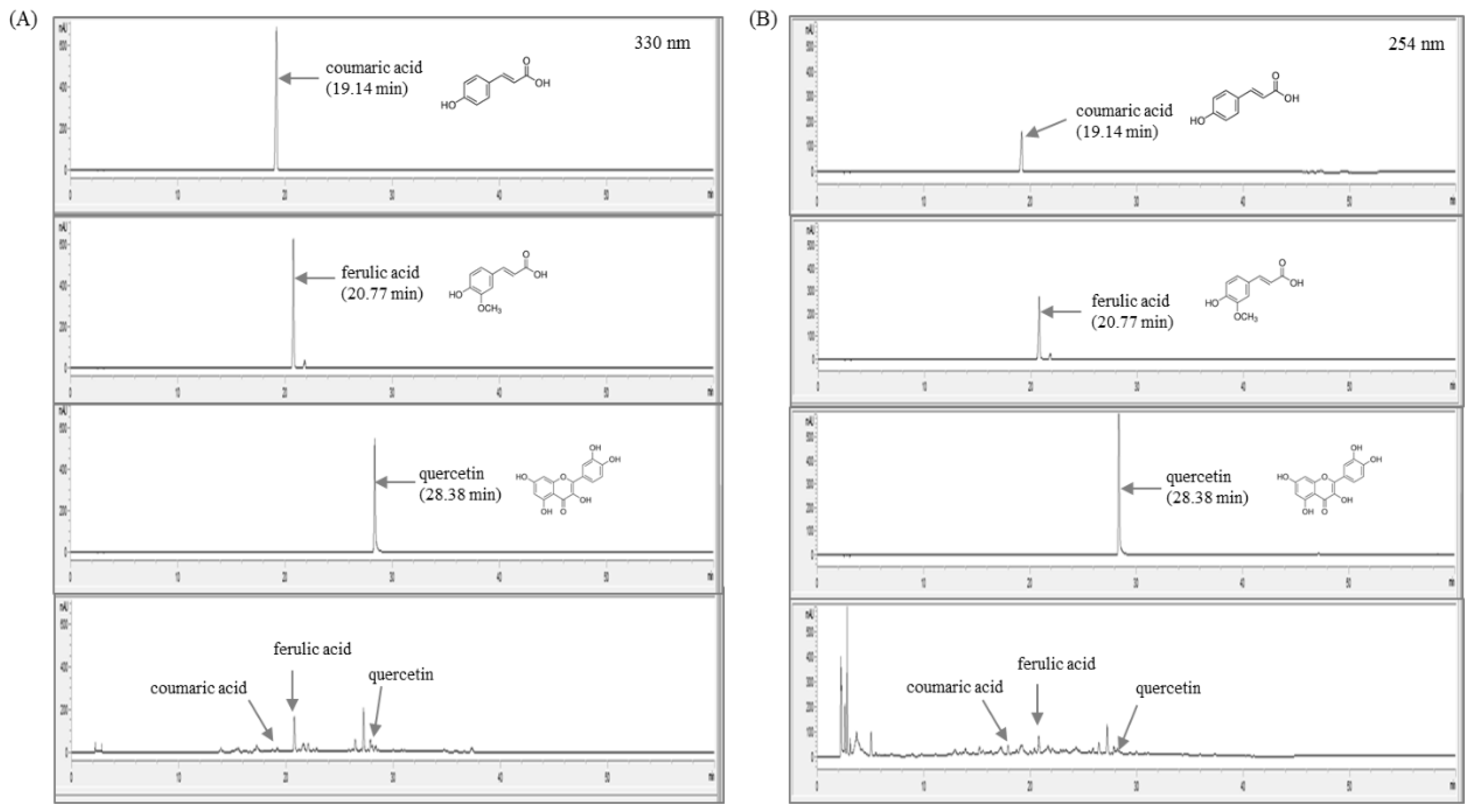
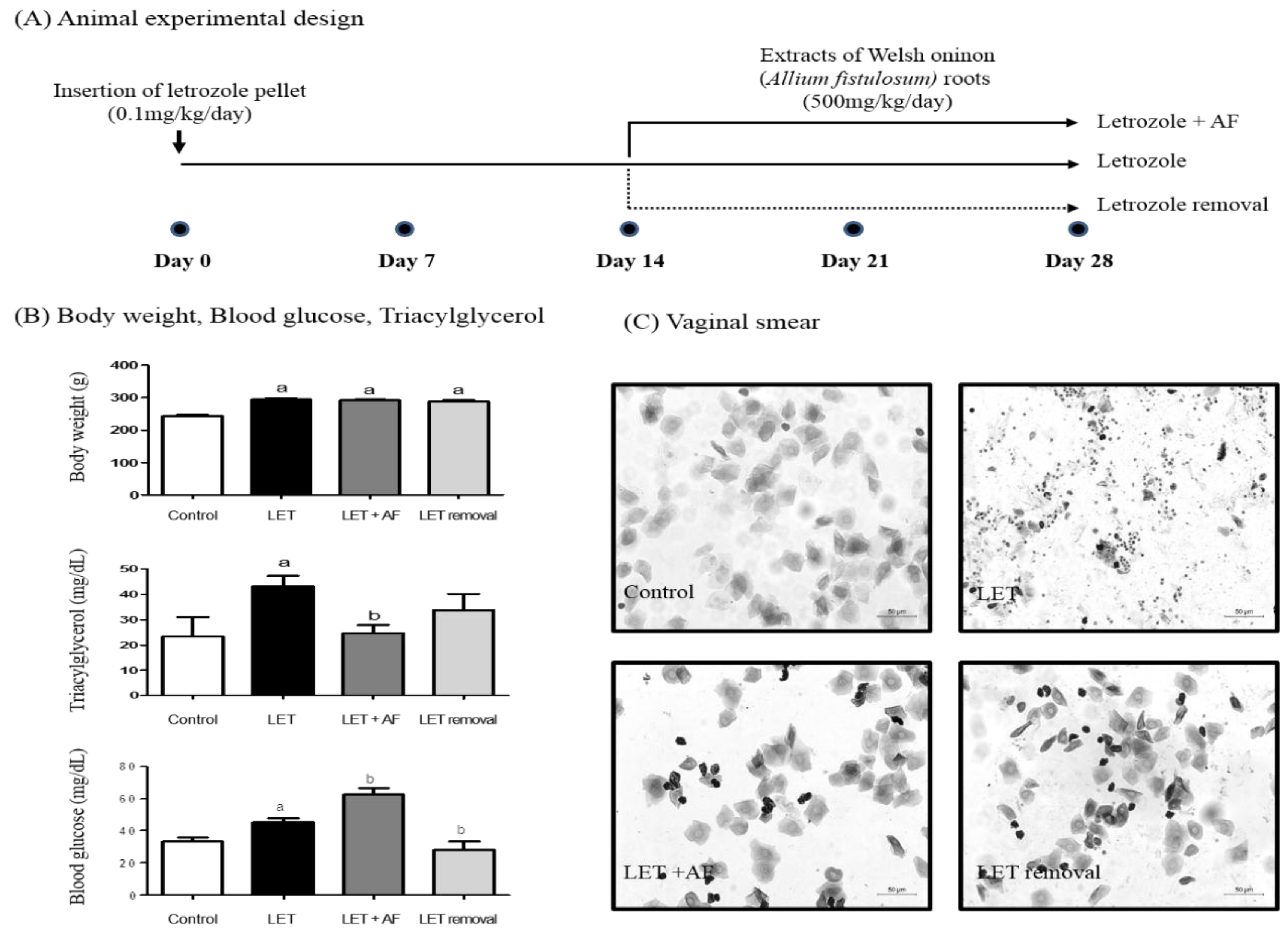
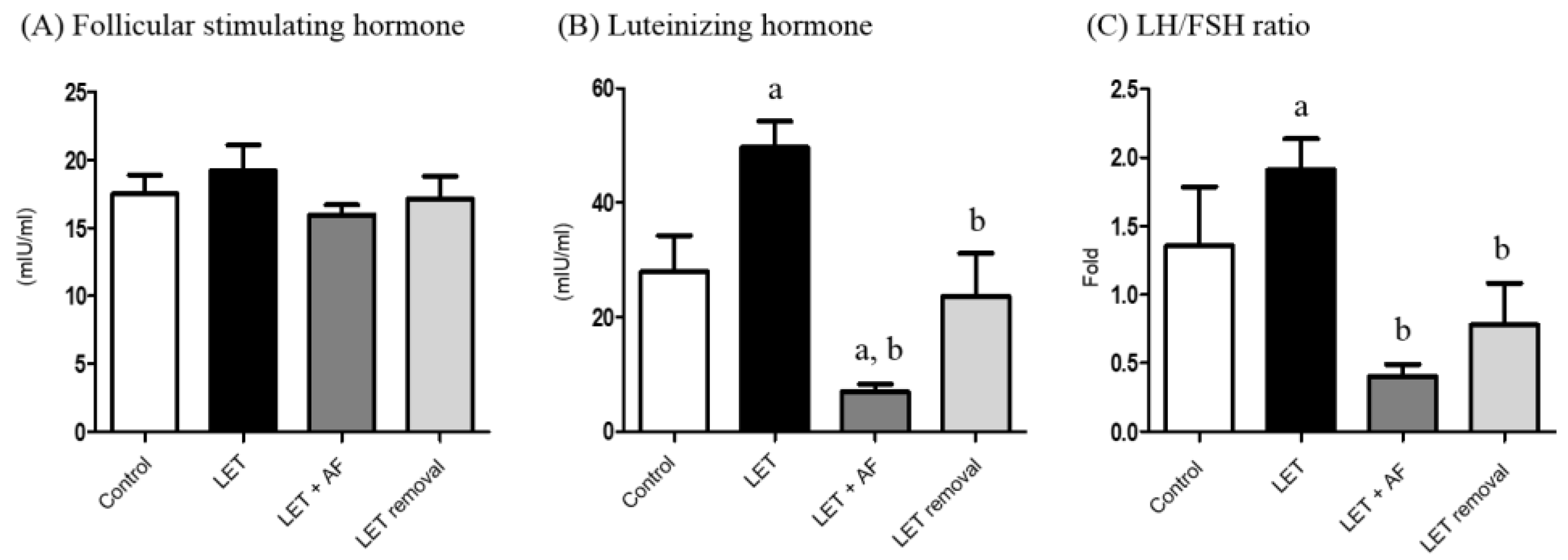
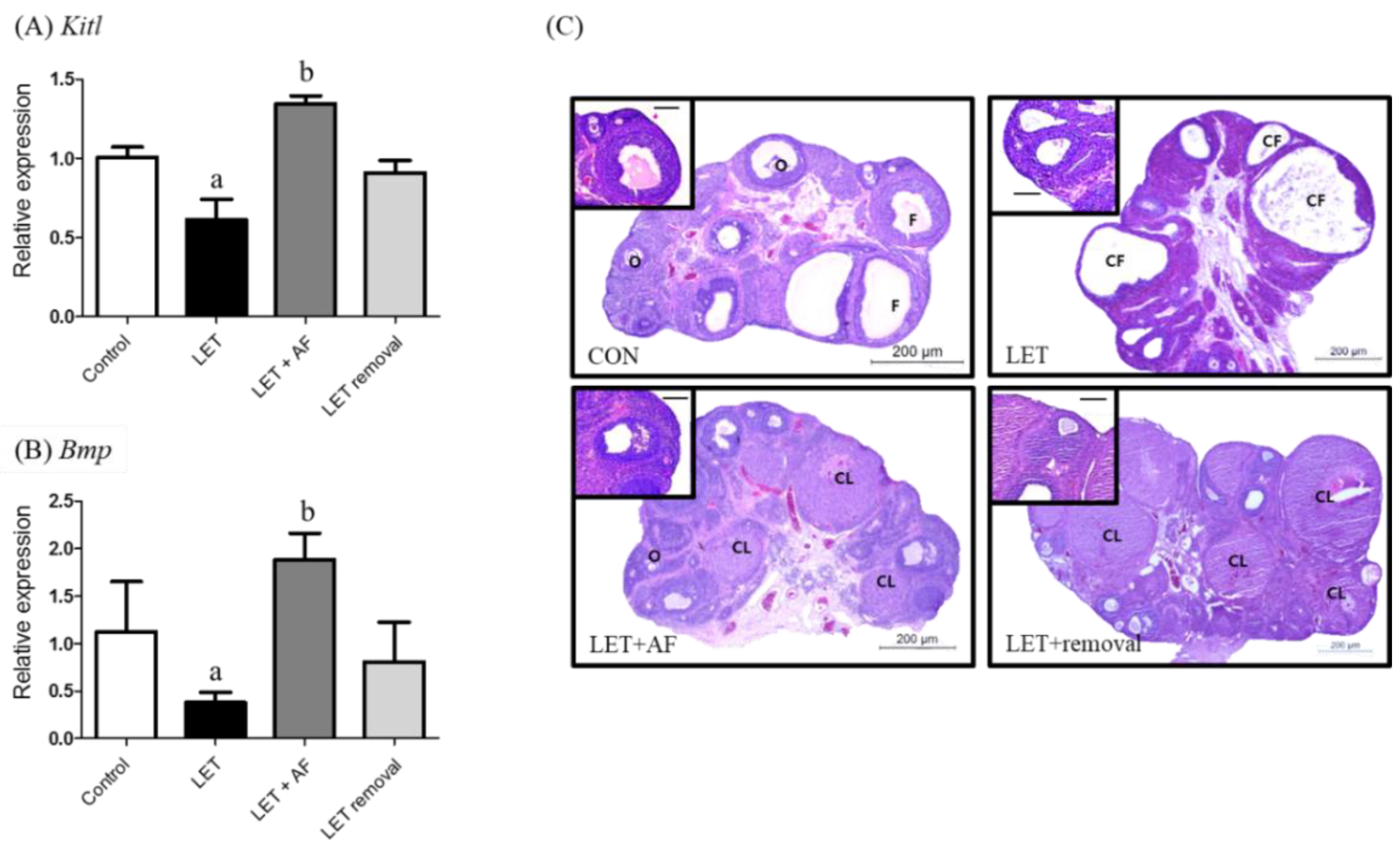
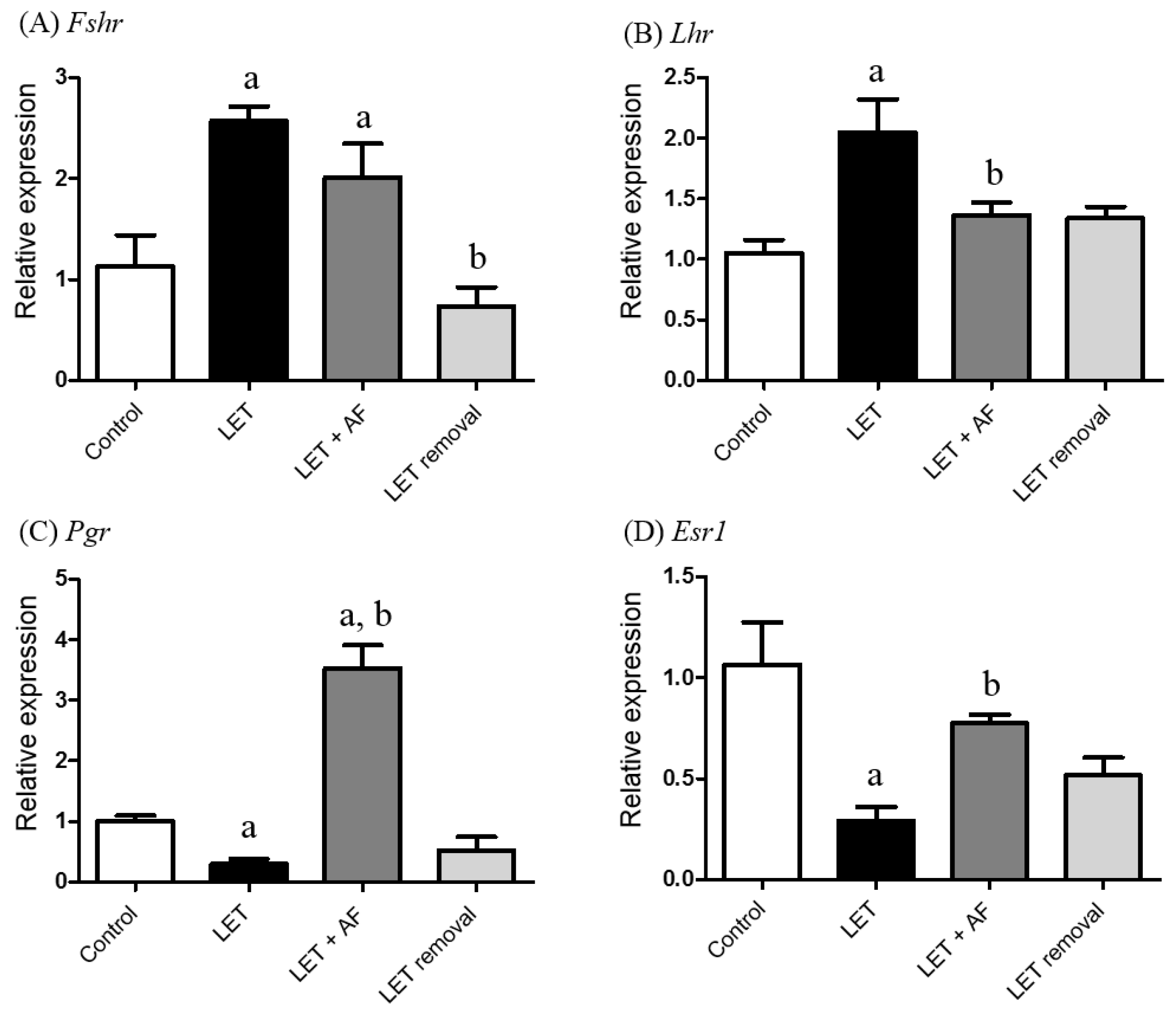
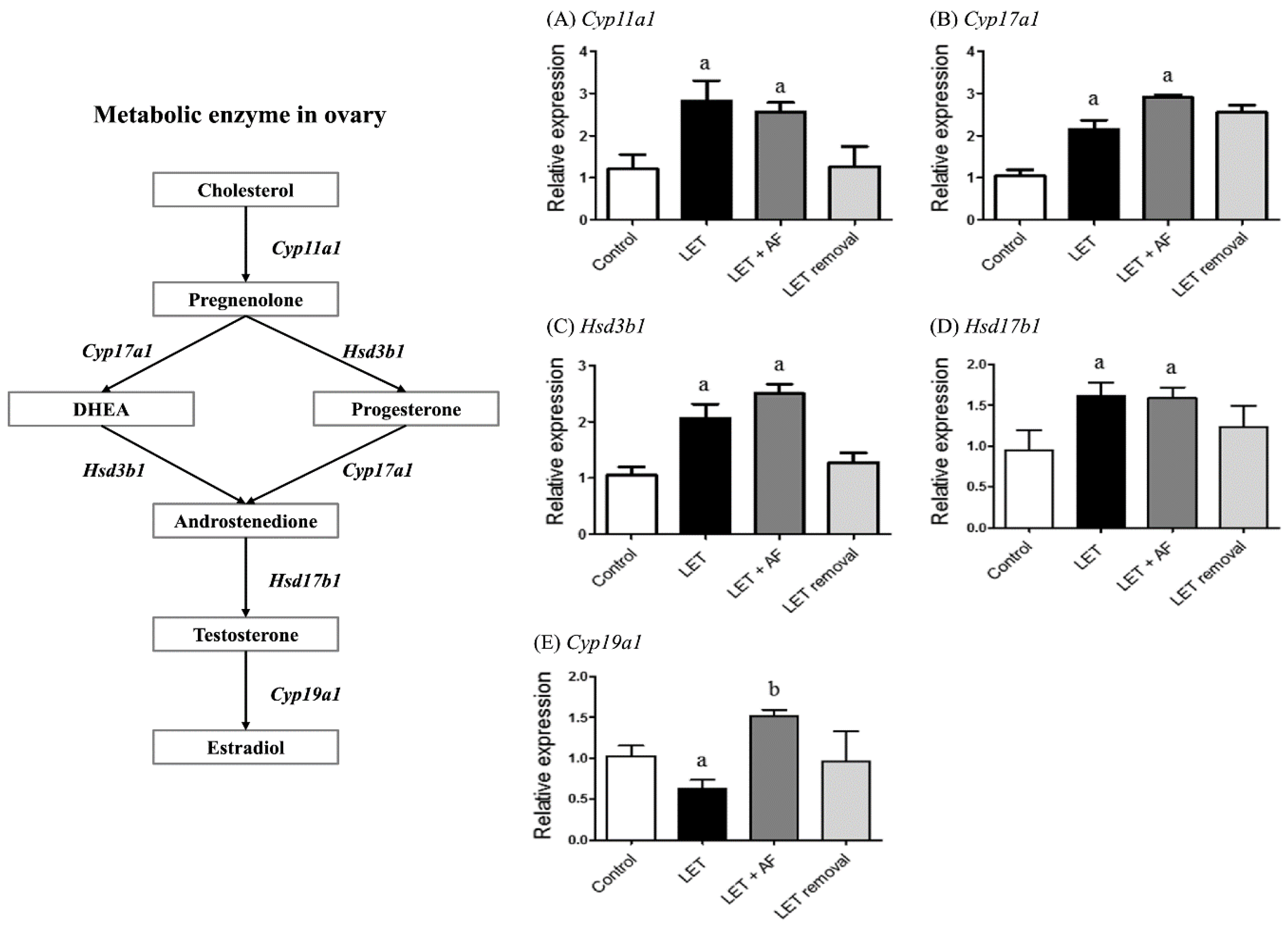
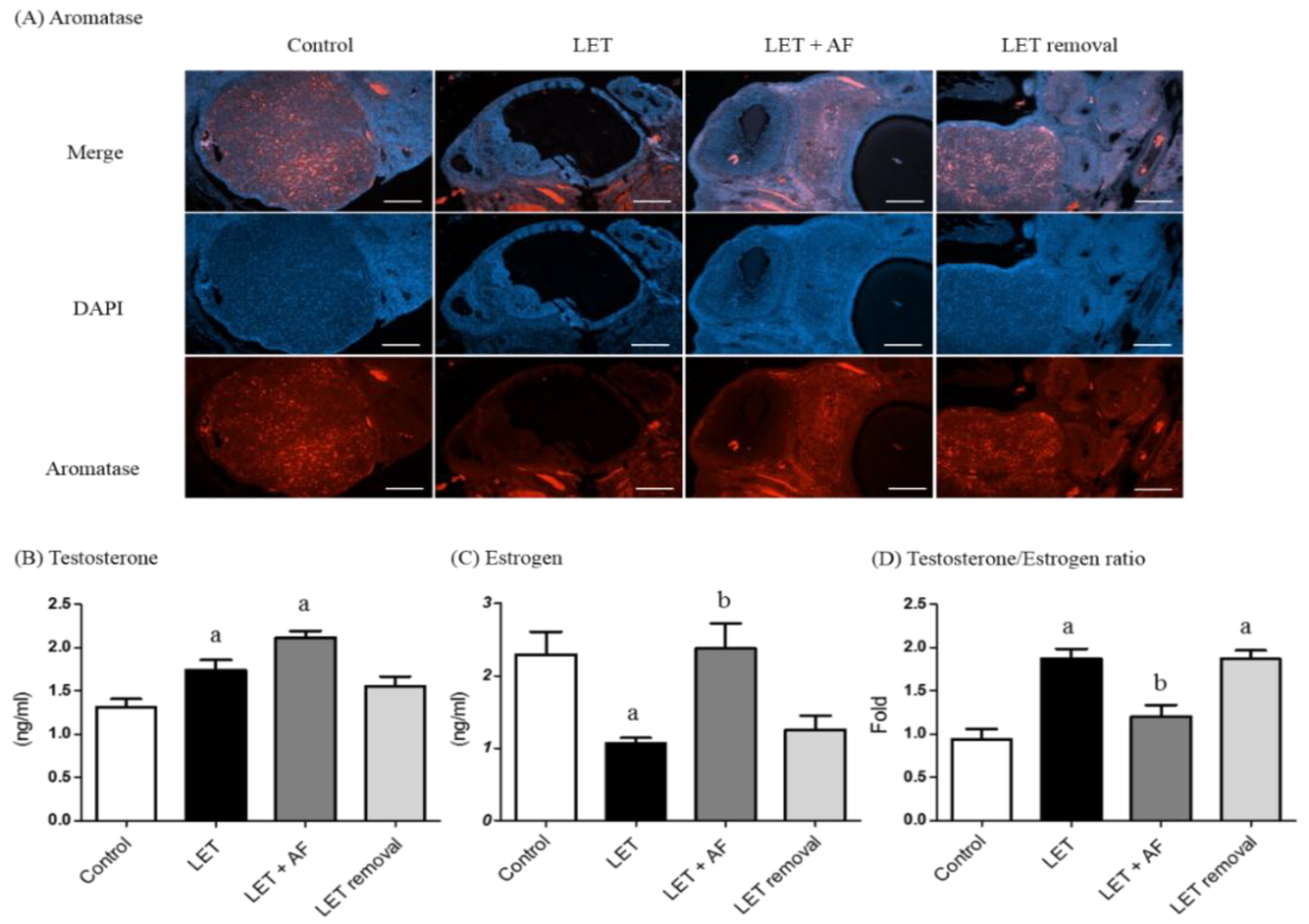
| Gene Name | Upper Primer (5’–3’) | Lower Primer (3’–5’) |
|---|---|---|
| Kitl | GGT AGC CAG GAG TTT GTT CT | TTG TGT GGC ATA AGG GCT |
| Bmp | GAT ATT GAG TCT CAG CCC GA | AAC ATG CGG TTG CCT GTA |
| Fshr | CTC ATC AAG CGA CAC CAA GA | GGA AAG GAT TGG CAC AAG AA |
| Lhr | ACA CTG CCC TCC AAA GAA AA | CCT CAA AGA TGG CGG AAT AA |
| Pgr | AGT CTA CCC GCC CTA CCT CA | AGC TCC CAC AGG TAA GCA CA |
| Esr1 | GAA GGC TGC AAG GCT TTC TT | TCT TTT CGT ATC CCG CCT TT |
| Cyp11a1 | AGG TCC TTC AAT GAG ATC CCT T | TCC CTG TAA ATG GGG CCA TAC |
| Cyp17a1 | GCC CAA GTC AAA GAC ACC TAA T | GTA CCC AGG CGA AGA GAA TAG A |
| Hsd3b1 | TGG ACA AAG TAT TCC GAC CAG A | GGC ACA CTT GCT TGA ACA CAG |
| Hsd17b1 | ACT TGG CTG TTC GCC TAG C | GAG GGC ATC CTT GAG TCC TG |
| Cyp19a1 | ATG TTC TTG GAA ATG CTG AAC CC | AGG ACC TGG TAT TGA AGA CGA G |
| Rplp0 | CTC AGT GCC TCA CTC CAT CA | CTT CCT TTG CTT CGA CCT TG |
| Compound | Detection Wavelength (nm) | Retention Time (min) | Linear Range (μCg/mL) | Regression Equation (y = ax + b) | Correlation Coefficient (r2) | Content † (μg/mg) |
|---|---|---|---|---|---|---|
| Courmaric acid | 330 | 19.14 | 3.0–200 | y = 29.462x − 141.067 | 0.999 | 0.168 ± 0.005 |
| Ferulic acid | 330 | 20.77 | 3.0–180 | y = 28.045x − 107.988 | 0.999 | 0.988 ± 0.005 |
| Quercetin | 254 | 28.38 | 3.0–200 | y = 34.2023x − 154.1267 | 0.999 | 2.591 ± 0.037 |
| Group | CON | LET | LET + AF | LET Removal |
|---|---|---|---|---|
| Number | 7.83 ± 2.64 | 13.50 ± 4.37 | 4.43 ± 1.13 * | 3.60 ± 0.55 * |
© 2018 by the authors. Licensee MDPI, Basel, Switzerland. This article is an open access article distributed under the terms and conditions of the Creative Commons Attribution (CC BY) license (http://creativecommons.org/licenses/by/4.0/).
Share and Cite
Lee, Y.H.; Yang, H.; Lee, S.R.; Kwon, S.W.; Hong, E.-J.; Lee, H.W. Welsh Onion Root (Allium fistulosum) Restores Ovarian Functions from Letrozole Induced-Polycystic Ovary Syndrome. Nutrients 2018, 10, 1430. https://doi.org/10.3390/nu10101430
Lee YH, Yang H, Lee SR, Kwon SW, Hong E-J, Lee HW. Welsh Onion Root (Allium fistulosum) Restores Ovarian Functions from Letrozole Induced-Polycystic Ovary Syndrome. Nutrients. 2018; 10(10):1430. https://doi.org/10.3390/nu10101430
Chicago/Turabian StyleLee, Young Ho, Hyun Yang, Sang R. Lee, Sun Woo Kwon, Eui-Ju Hong, and Hye Won Lee. 2018. "Welsh Onion Root (Allium fistulosum) Restores Ovarian Functions from Letrozole Induced-Polycystic Ovary Syndrome" Nutrients 10, no. 10: 1430. https://doi.org/10.3390/nu10101430
APA StyleLee, Y. H., Yang, H., Lee, S. R., Kwon, S. W., Hong, E.-J., & Lee, H. W. (2018). Welsh Onion Root (Allium fistulosum) Restores Ovarian Functions from Letrozole Induced-Polycystic Ovary Syndrome. Nutrients, 10(10), 1430. https://doi.org/10.3390/nu10101430





